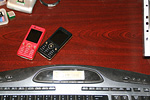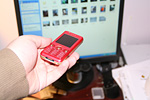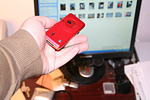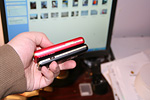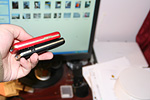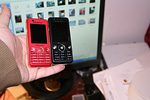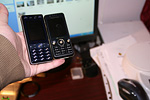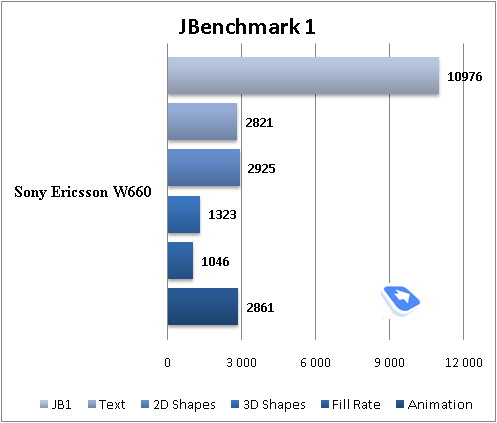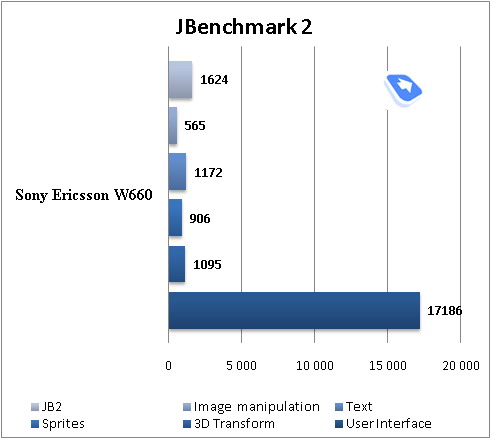|
|
Review of GSM-handset Sony Ericsson W660i
Live photos of Sony Ericsson W660i
Sales package:
- Handset
- Battery (BST-33)
- Charger
- USB data cable
- Ì2 512 Mb memory card
- CD with software
- Wired stereo-headset HPM-70 (black)
Sony Ericsson has started intensively extending its range with a little bit modified editions of already existing devices. Sony Ericsson W660i is one of those, sporting some of the vendor’s latest emotional tweaks: light effects, design, more trims differing from its forefather, the Sony Ericsson W610i. Saving for the 3G connectivity, these two are nearly totally identical, especially at a glance, but delve deeper and you will find that on Sony Ericsson W660i the interface port sits at the bottom rather than on the side plate and it has a conventional number pad. While the alterations are few, they do enhance the experience you come away with after using it. To me, it is even more obvious – Sony Ericsson W610i lying edgeways is not very interesting. Regrettably, at that the manufacturer has left autofocus-enabled camera off the board, installing a quite basic matrix and removing flash and self-portrait mirror.
Design-wise, there are only a few things that set the two apart – placed hand to hand they look like to variations of one model, which is in fact, exactly how matters stand. The differences include the lens of the forward-facing camera in the W660i.



Two color solutions for Sony Ericsson W660i –Rose Red and Record Black – have much appeal, as I see it, at that the black-painted phone will obviously fit in both men’s and women’s hands, whereas the red-coated W660i is meant solely for women.


The women-aimed variation features flower pattern on the back, while on any black handset these would be replaced by uncomplicated circles alone.


Measuring up at 102x46x14.5 mm (like the W610i), the W660i is pretty skinny, yet not too much. The handset’s thickness will be appreciated by those denying all ultra-slim products and who have used to have a robust feel of a casing in hands. On the other hand, the W660i won’t be a burden in a trousers or shirt pocket, fitting in there just fine. The phone weights 93 grams, which makes it 1 gram too heavy, compared to the W610i.






For its mid-range the company is not planning on shifting to QVGA-display, which is the trait of the senior solutions, like Sony Ericsson W850i. A 176x220 pixel display is still not an anachronism, yet not a cutting edge no matter how you put it (for example, lagging behind in terms of functionality, Nokia 6233 shows off a superior screen and thus evens out with it). The screen measures 1,9 inches (31x40 mm) diagonally and shows up to 262 K colors (TFT). The first thing you come across is big fonts, prominent titles of the menu items – this is what makes it look different compared to the senior products. Reading texts with the W660i is a breeze, all thanks to the display and implementation of fonts. The screen can accommodate up to 6 text and 3 service lines. Unlike some other offerings, the W610i’s display doesn’t enjoy a protective layer that would guard it from sunlight, however in the sun picture remains visible, even though the colors appear washed out. Maybe they have applied a new finishing technology that makes for better visual experience.


The numeric keys are lit in white, which is visible in various environments. Being quite bulky and thus easy to work with, these keys is what sets the W660i above Sony Ericsson W610i, where the keypad will do for fewer users. To my mind, the late arrival of the W660i in the market is justified from this standpoint; however the W610i’s keys have some stylish looks to them, that’s for sure.
The functional buttons are also convenient to deal with – the central one is edged with a glimmering rim, that goes live with various colors in step with music or ring tone. The area that glows is very small, however in the dark there are no chances to you will miss it.
The plastic used in the back cover is too slim, and should you bend it a bit more than usual it starts creaking. Though its thickness is likely to keep low profile unless you drop the phone (and the probability that it will land in the worst way possible is tiny).


The cover doesn’t know what gap is and hides 950 mAh Li-Pol battery (BST-33) underneath. The maker quotes the lifetime at 7 hours talk time and 350 hours standby time, plus up to 25 hours of music playback. In conditions of Moscow networks the handset lasted about 3 days at a bit more than one hour of calls, up to 30 minutes of web surfing and 1,5 hours of music playback a day. We also give its official playback time a go and set the W610i at full blast with default headphones and random playback, which resulted in 23 hours of real lifetime. Apparently, it is the best figure we have seen from a handset – the second best lifetime put up by other company’s proposal makes up 18 hours, while vast majority of cell phones keeps themselves up and running for 10-12 hours in this mode (like the first generation of Walkmans). It takes the W660i about two hours to charge from empty to full.

On the left spine is a covered M2 memory cards slot – the flap it is sealed with is made of soft rubber, which tends to bend and thus doesn’t plug up the socket properly The dedicated music keys sits on the left as well – its flick starts up music playback (player or radio), however music player can be called up with the W button on the front.
The right side features camera shortcut, as well as the volume rocker. The top rim holds Infrared window and the power button, doubling as a profile changer and key locker. Turning the handset round reveals a 2 Mpix camera and a sole speaker, which is very loud and penetrating.
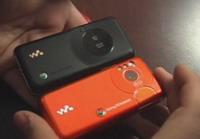
Video, handling the device, comparison of dimensions (mpg, 18.80 Mb)>>>
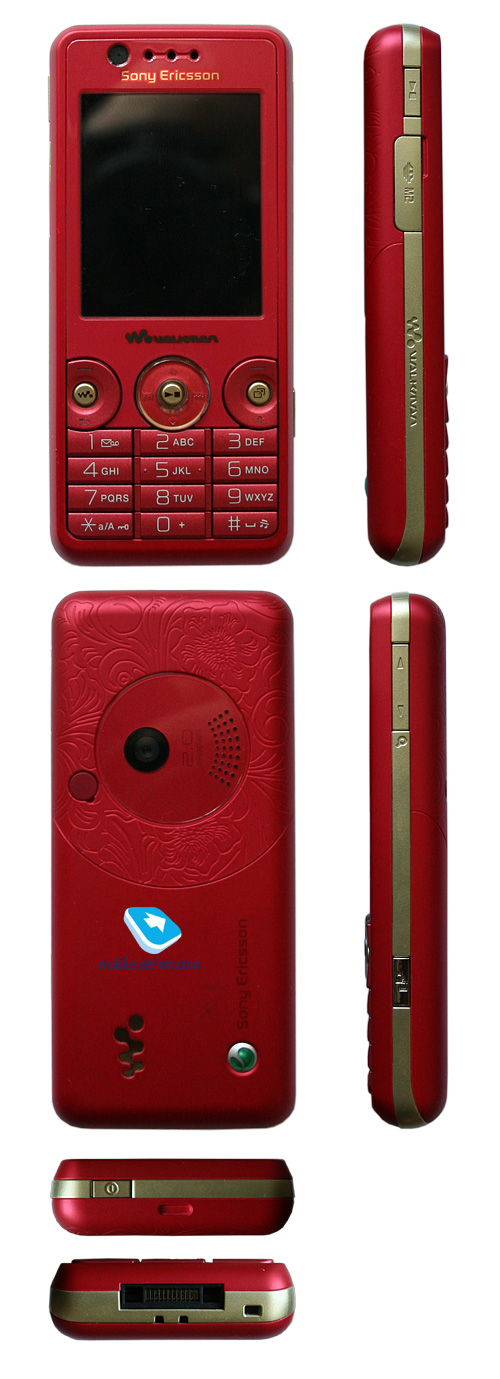

Menu
The W660i’s software part comes as no surprise, as it is in fact a typical Sony Ericsson-branded handset with Walkman 2.0 interface onboard, revamped image editor chucked in, and mostly coinciding suite of functions with Sony Ericsson W610i. The company steadily improves functionality of its main range and never forgets to add some new functions to a handful of solutions time after time. In the past it was Timeline View in the Gallery, this time around enhancements took the form of stand-alone video player with snapshot ability, revamped image editor and music player.
The main menu pops up before you as a grid consisting of 12 icons (one of the themes also features horizontally laid out menu). Shortcut number navigation is on the W880i’s spec sheet as well – you can assign shortcuts to most menu items, that the handset comes pre-installed with, whereas own applications or files can’t be set up for one-touch access.
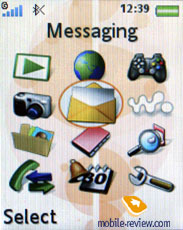 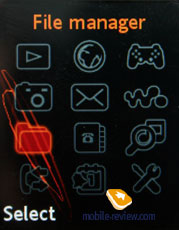
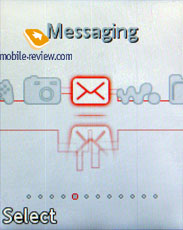
Text input has remained on the same comfort level, so, pressing the "#" key brings out a list of the available languages and you can easily switch between them while typing.Besides traditional vertically arranged sub-menus, the maker has provided subject-based horizontal tabs. It means that while viewing a list of the dialed numbers, one can see not only the dialed numbers but in the same time (by leaning the joystick horizontally) switch between missed and received call tabs. In the phone menu this kind of navigation is provided anywhere it's possible and it makes for much better usage experience. The menu ergonomics is quite high in this phone. I also have to note that such horizontal tabs appear in Phonebook, Settings and other menu items as well.
Activity Menu is standard Sony Ericsson fare. The first three tabs display various events, like missed calls, memos, messages – actually all this can be found in the first tab. One can disable Activity Menu for these events as well – in this case pop up windows, reminding of a certain event type will appear on the screen. The third tab features the shortcuts, which you should set up yourself. And the added fourth one contains links to the most frequently used applications and resources – and the top of this list is claimed by Google search.
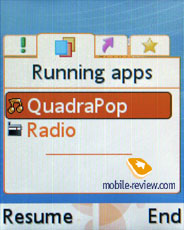 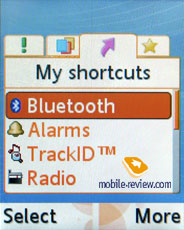
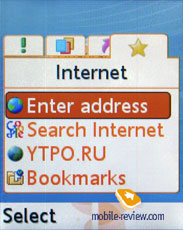
The second tab is the most interesting, since it appears to be some kind of a task manager, featuring the list of all currently running applications. User is able to have up to eight Java-applications launched (in fact there are no severe caps, yet the RAM cannot bear more than 8) simultaneously and switch between them. This may come in handy, in case you use an ICQ-esque mobile client, which should be constantly online, and at the same time want to play a Java-game. Up to now counterparts of this solution by other manufacturers haven't been announced.
On USB-connection you are forced to pick connection type – specifically whether you will be accessing data stored on the memory card or just keep managing the phone or activate Print mode. For the first mode we mentioned above the handset goes off and you gain access to the contents of both the memory card and the phone internal memory. Despite the maker claiming it to be USB 2.0, data transfer speed doesn’t exceed 500 Kb/s. If you just want your W660i to turn into a modem, then pick the second option, when you will have a chance to play around with various USB settings for going online.
Phonebook. Up to 1000 contacts with fully filled in fields can be stored in the phonebook, but number of phone numbers is limited to 2500. This means that despite the ability to assign up to 5 phone numbers to one contact, you cannot go over 2500 entries. This is enough even for the most active users, as only few have more than 500 entries in their phonebooks.
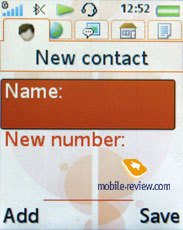 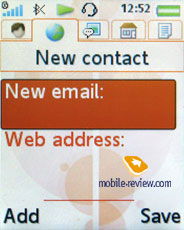
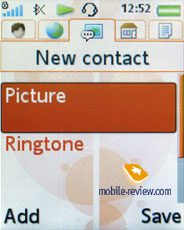 
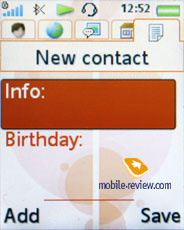 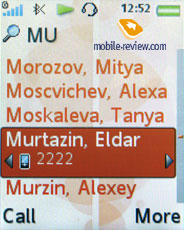
As mentioned above, several phone numbers can be submitted for one contact, as well as address, email, IM number, other contact information. In settings you can select the required fields, they will be available, meanwhile the useless ones will not be presented. Contacts can be sorted by fields, including name and surname, but only one input field. Unlike previous models, this time we have dynamics on - handset automatically sorts the list after changes.
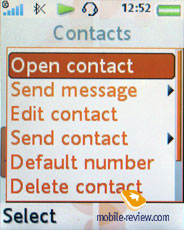 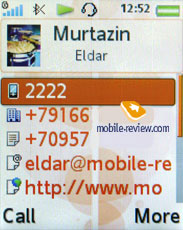
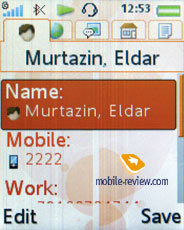 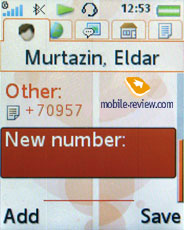
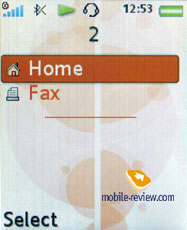 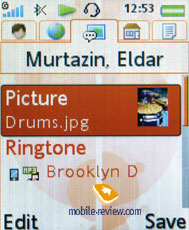
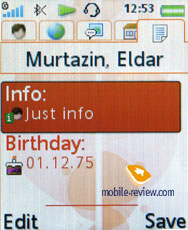 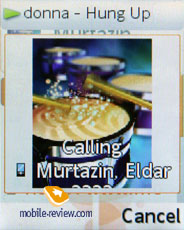
It is possible to assign custom ring tone and photo to each contact. On incoming call the image and ring tone will be used. Date of birth field can be synchronized with Organizer, at that you will have a chance to set how many days prior to the event the handset should warn you.
When you are typing in information, you can scroll between tabs, in the first one you enter phone numbers, categorize them by types. On the whole the organization of this process reminds of Outlook, and it means comfort in the first place. Voice tags can be added for required phone numbers, names, there can be up to 40 of them. Voice dialing remained the way it was many months ago, it starts looking archaic with all these voice independent recognition software being implemented by the competitors.
The company still follows its traditional beliefs that SIM-card is used only in case of emergency, that’s why the only way to see its contents is to go into special option in the menu. SIM contacts are not displayed in the general list.
You can create a back-up copy of all entries in phonebook, which will be stored on the memory card, so that you will have the ability to restore them afterwards.
Contact Groups serve only for mass SMS sending, since it is impossible to bind custom ringtone or photo for Group.
Any video clip may be used as Caller ID for a contact in your phonebook.
Messaging. All tools used for managing messages are standard, there are some templates available and you can come up with some more of your own. Phone’s memory together with SIM-card is used for storing messages. Chat function is supported. On the whole everything is just like in any other phone from this company. Only emoticons icons have changed – now they look much more attractive.
 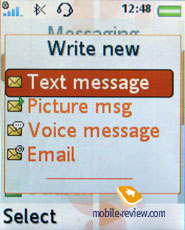
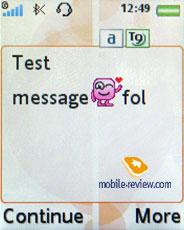 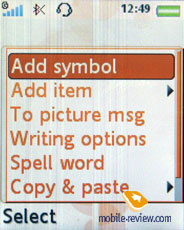
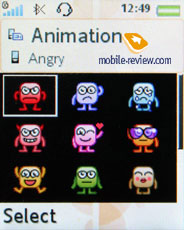 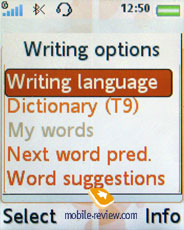
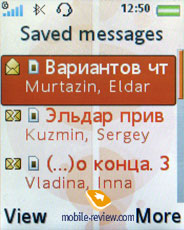 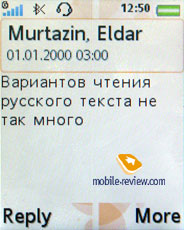
The MMS implementation is as always great, you can literally create video clips, there are lots of settings and this is one of those things that give SE’s product a cutting edge over competitors.
E-Mail client can send and receive e-mails, all sorts of encodings are supported. The emails can be stored on memory card.
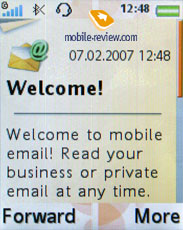
In email settings you can setup separate password for SMTP-accounts, this is very convenient. The settings are flexible, support for almost all encodings, and not only Unicode has been added. Attachments that are supported by the phone are presented as icons in an email’s body. The phone doesn’t recognize office files or PDF, but they can be stored in any directory. The limit for outgoing/incoming email size is set by operator. Emails with 6-7 Mb attachments can be sent without any hassles. The phone supports Push Mail standard. Naturally send & receive process is carried out in background mode.
RSS Feed. The settings for this item are really simple - you just specify the title for feed and its address. The phone will connect and download it without your assistance. You can update only one item, or the whole feed at once. Capabilities of built-in browser are used for displaying the feeds. Feeds may be updated on schedule.

Call list. Up to 30 records can be stored in the general list, all with date and time. Icon that stands for call type (missed/received/dialed) is shown next to each entry. Besides this additional icon identifies if this phone number is present in the phone book or SIM-card. The list of missed calls can be viewed separately and stores up to 10 entries. In this menu you can also see the cost and length of all outgoing calls and last call. Navigating through the lists works with the help of tabs and this does save much time.
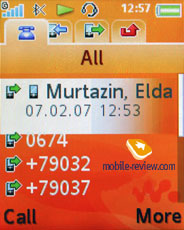 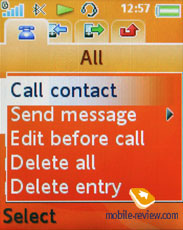
Entertainment. Photos, music files can be accessed from this menu. MusicDJ function is rather interesting, even though it is a niche solution and there is not much of a chance that this feature will be highly demanded. In the editor you can create ring tones and edit up to four bands.
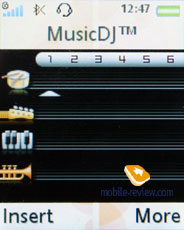
Advanced version of MusicDJ is called VideoDJ, it allows editing not only music files, but also adding images and signs. The resulting file is recorded in .3GP file which can be sent by MMS or Email, or just transferred to another phone.
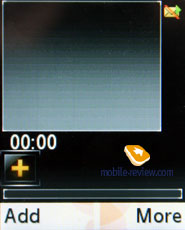 
PhotoDJ has kept the name but had its inners completely revamped. The manufacturer has partly removed the shroud handing over the impending CyberShot projects, which will feature this editor by default. Now tell us, how often do you draw with your handset or create own pictures? The answer for most will be as clear as it only could be – never. At the same time getting rid of red-eyes effect, adjusting a shot’s brightness, contrast, sharpness, overlaying some effects, might well come in handy on certain occasions, but to do that you frequently have to wait the moment when you get photos uploaded to a PC. The new PhotoDJ looks to make performing these most basic actions as easy as it has never been before, enhance the handset with the ability to carry out these operations on the go. This move is definitely a big plus for Sony Ericsson and will be followed by other companies; and Nokia will be in the first rows (such functionality will get to its phones due out in the second half of 2007).
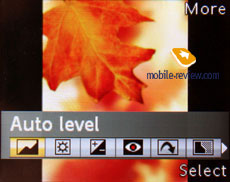 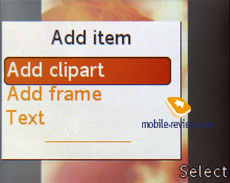

Remote control – ability to control other devices via the phone’s Bluetooth connectivity. It is standard for all phones made by Sony Ericsson
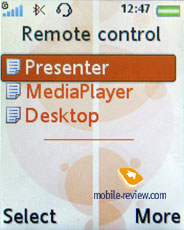
The sound can be recorded by Sound Recorder - it allows making clips that can be later used as ring tones. Phone calls can be recorded too, this is done from context menu, no time limits are set for the Sound Recorder.
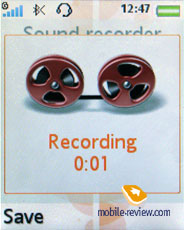
Games – the handset plays host only to one game – tennis.
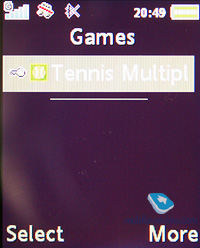 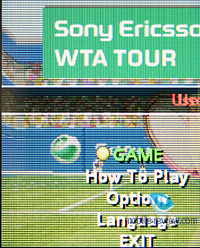

Organizer. Organizer keeps a lot of functions underneath. Let’s get Calendar out of the way first. There are three view modes embedded in the W660i’s calendar: weekly, monthly and daily. The last option displays the list of all events and memos, in two others you will see highlighted time or day. You can switch to required day and year, or month. So everything is pretty simple, just as the schedule input is. You get the ability to name the event, define the place where it will take place, set length and setup the reminder (before or right at the start of the event). Recurrent events support is also onboard. Types of reoccurrence: daily, monthly, yearly. Reminders work even if the phone is turned off as well, unless you disable this function.
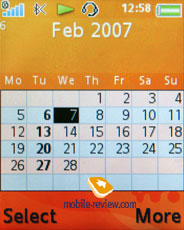 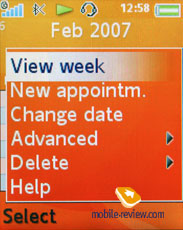
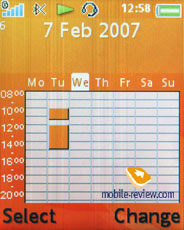 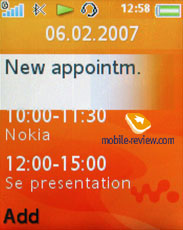
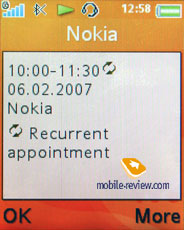
To do list in this phone is quite ascetic. There are only two types of events: phone call and reminder. On the other hand, this is really enough, simplicity has its own advantages.
 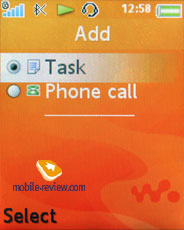
The phone has full-fledged search, set up for calendar: you specify the search line (word or part of it) and after a while you will see all events that match this criteria. The function is quite speedy even if the organizer has more than 100 entries; fast switch to the event from the search window is supported.
The phone features transfer of schedule to various devices (traditionally via IrDA and Bluetooth). Choose the required interval (day, week or month) and send all entries – it is that simple. I’d like to point out that the device should support PIM function in order to open and display this data properly. It is possible to send the schedule to TV-set through IrDA connection, the TV-set accepts it but is unable to display the received information. Data can be received the same way, with the help of desktop or office PC without any additional software.
Notes. The phone supports notes entry, though they are limited in length. The name of the note you see on the list will be first word entered. This is not always convenient since you will have to think of the first word that would tell you what the note is all about.
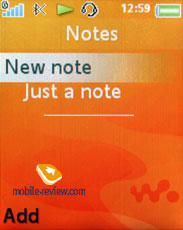 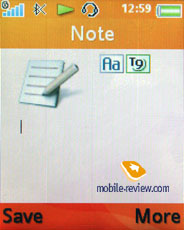
Alarm Clock. Now you have access to five alarm clocks, and each of them can be set up manually. They can work in definite week days. Besides the ring tone for alarm clock you can select small note and picture, they will be displayed when alarm clock goes on. Any music file can be assigned as the alarm tone.
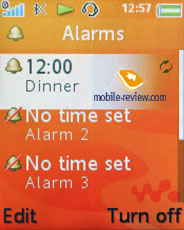 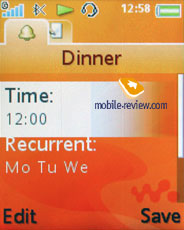
Stopwatch/Countdown. Here everything is quite standard, although the same can be said of the stopwatch that has intermediate times function. The phone has special application for storing secret codes, which was a huge success in previous models, well, standard calculator is onboard too.
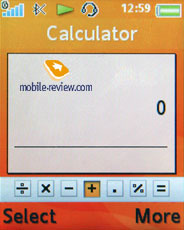 
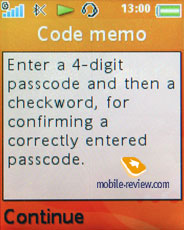 
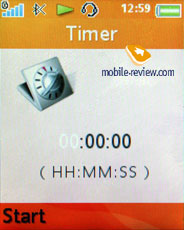
Connectivity. All connectivity settings for the phone can be setup from here, starting from WAP and GPRS (the EDGE settings are same) to Bluetooth and Synchronization. I will not describe the standard options, they are kind of standard in the first place, and everything works fine. I’d like to highlight stable Bluetooth operation - no problems were encountered, synchronization with other devices runs smoothly, all profiles (including A2DP, which is stereo sound via Bluetooth) are supported. EDR-enabled Bluetooth version is 2.0.
 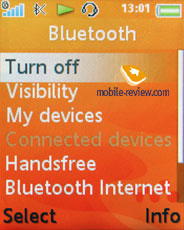
Local and Remote synchronization can be setup from the same menu. The phone supports HID profile which allows using it as Remote control for PC and other devices.
The following Bluetooth profiles are supported:
- Dial-up networking profile
- Generic Access profile
- Generic Object Exchange Profile
- Object Push Profile
- Serial Port Profile
- Handsfree Profile
- Headset Profile
- Synchronization Profile
- Basic Imaging Profile
- File Transfer Profile
- HID Profile
- SyncML OBEX binding
- JSR-82 Java API
- A2DP
WAP. The browser owns separate menu item, the version is 2.0, it supports secured connections which is quite important in case you are using electronic transactions. New wallpapers, themes and ring tones can be downloaded right away – all this is available at the original web-site.
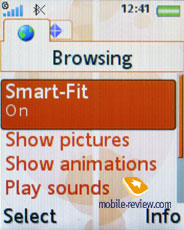 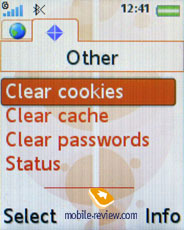
Standard browser for Sony Ericsson phones is NetFront, which supports single-column web pages display and HTML. One of the best things about it, is the ability to create folders with files and bookmarks. The browser is considered to be one of the market’s best offerings, but limited phone resources do it no favors. On the whole those using Internet constantly should consider buying PDA or laptop, since full-fledged Internet access is not an ultimate must-have for this device type. At the same time RSS Feeds support is great, it allows using the phone for reading news, announcements and articles on the go in a convenient fashion.
HTML pages that contain advanced formatting or exceed 500kb in their size will not be displayed. On the whole standard browser is all fine, but usage of Opera Mini is preferable, since it has got way more to offer.
Settings. This menu stores all settings related to the phone’s operation. In the stand by mode clock can be displayed at the bottom (on or off), you an also alter the font size, in case you select big letters it will be easy to see what time it is, but the font itself becomes a tad transparent. There isn’t anything to add, all the rest is standard.
 
The themes allow for altering not only the interface appearance, but the main menu layout as well.
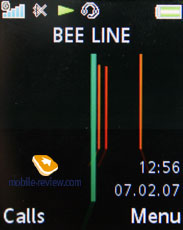 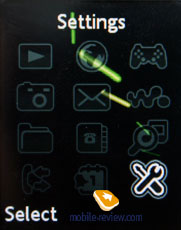
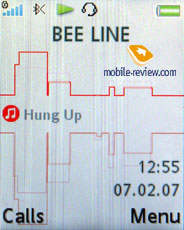 
File manager, memory size. The user has 18 MB of available memory at his disposal, add empty M2 memory card to that too. Here all data (photos, videos, applications) can be stored. The remaining memory is occupied by preinstalled applications, which cannot be wiped. Part of memory is dedicated to phonebook, call lists, etc.
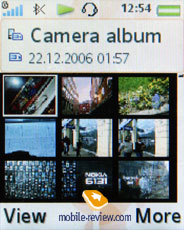
The phone has a basic file manager, with its help files can be sorted by various folders, custom directories can be created in phone’s memory, files can be moved there as well. With or without cable the phone can become a perfect storage, there are no problems with recording your own files, even if they cannot be opened by the phone.
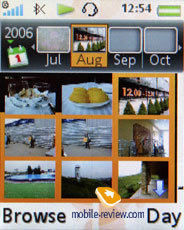 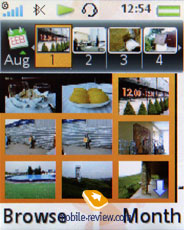
Traditional file sorting includes the following options: date, type and size. The Image Gallery has new setting called Timeline, after you activate it you will see a bar on which months will be shown. And in lists you will see photos that were made during this or that month. You can make the list more detailed by pressing the same key twice, in that case you will see days instead of months. This is a good way to wander in tons of images.
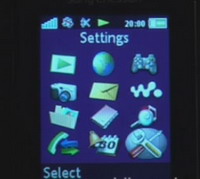
Âèäåî, ðàáîòà ñ ìåíþ (mpg, 30 Ìá)>>>
Camera. The handset comes equipped with a 2 Mpix camera utilizing CMOS matrix, yet it lacks autofocus and flash, it doesn’t have a self-portrait mirror either. The quality of shots it takes is far inferior to that of Sony Ericsson W610i, which has autofocus chucked in.
The device supports three possible resolutions - 1632x1224, 1280x960, 640x480 pixels. Two types of data compression, Normal and Fine, are at your disposal. The majority of the photos represented are in the Fine quality. The photos differ in size almost two times depending on the resolution. Thus a photo in the Normal mode takes about 300 KB when the Fine quality gives 500-600 KB. Saving the photo takes the same time not depending on the case, that is about 1-2 seconds, and that is quite well for such a file size.
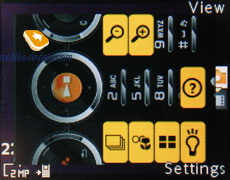 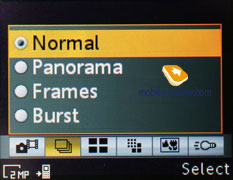
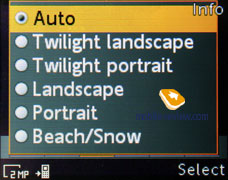 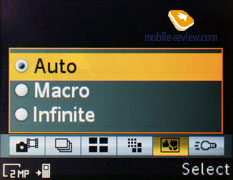
The camera settings look the following way:
- Shutter sound. You can choose on of the three shutter sounds but not turn the sound off.
- White balance. A possibility to choose between an automatic mode or Incandescent, Fluorescent, Daylight, Cloudy.
- Effects. Several effects may be applied to the photos, they are Negative, Solarize, Sepia, Black & White.
- Timer is activated for a certain time period for self shooting.
- Night mode is for shooting in the dark. Noises raise on a photo, exposition is increased (you shouldn't move the device in order not to get a blurry photo).
- Shooting mode. Normal mode, that is taking usual photos. A multiple mode (Burst 4) allows taking four photos for a series. Landscape is a very interesting mode that allows taking rather unordinary photos, has no rivals for the moment. The last mode is taking photos with frames, photo resolution decreases automatically.
- Scenes – auto, Twilight Landscape, Twilight Portrait, Landscape, Portrait, Beach/Snow, Sports
The screen serves as a viewfinder when in the shooting mode. The picture moves very smoothly and everything is clearly seen. Number keys help in switching between various functions and shooting parameters quickly that greatly speeds up the process of shooting.
 |
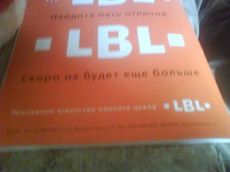 |
(+)
maximize, 1600x1200, JPEG |
(+)
maximize, 1600x1200, JPEG |
 |
 |
(+)
maximize, 1600x1200, JPEG |
(+)
maximize, 1600x1200, JPEG |
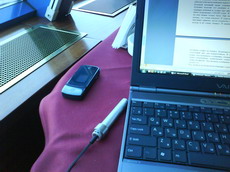 |
 |
(+)
maximize, 1632x1224, JPEG |
(+)
maximize, 1632x1224, JPEG |
 |
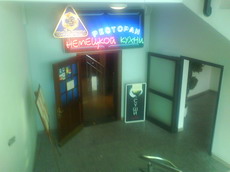 |
(+)
maximize, 1600x1200, JPEG |
(+)
maximize, 1600x1200, JPEG |
 |
 |
(+)
maximize, 1600x1200, JPEG |
(+)
maximize, 1600x1200, JPEG |
 |
 |
(+)
maximize, 1600x1200, JPEG |
(+)
maximize, 1600x1200, JPEG |
 |
 |
(+)
maximize, 1600x1200, JPEG |
(+)
maximize, 1600x1200, JPEG |
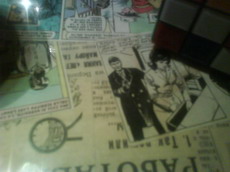 |
 |
(+)
maximize, 1600x1200, JPEG |
(+)
maximize, 1600x1200, JPEG |
 |
|
(+)
maximize, 1600x1200, JPEG |
|
Video may be recorded in two resolutions (176x144, 128x96), file format is 3GP. Clip duration may be limited (up to 10 seconds) or unlimited. The quality of the clips is average and obviously inferior to many top models.
Video sample (3gp, 246 Kb)>>>
Video player. The manufacturer has singled out the player in an individual menu item for the purpose of emphasizing how different it is compared to the music player, and other makers’ offerings, where video and music players share one section. On the plus side is ability to playback QVGA-clips at 30 frames per second, progressive fast-forward feature, landscape mode switcher, auto-scaling of high resolutions down to the display’s size. And the last, but of course not the least, highlight on the list is possibility to get snaps of frames of the played back video, which are saved as pictures and can be used in whatever way you like afterwards.


Radio. The W660i has memory capable of storing up to 20 FM radio stations and the auto-tuning ability, as well as RDS feature onboard. The Radio application used here is no different from that found on the K750i quality-wise, meaning that it is mostly fine. The handset comes bundled with HPM-70 stereo-headset
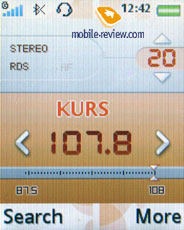 
Walkman version 2.0 player. The first update to the Walkman 1.0 is a facelift, but it’s obvious: interface color is black, not orange. Changing color was a good idea, interface looks interesting. Player can be accessed from stand by mode by pressing orange Walkman key. Pressing it again will minimize player.
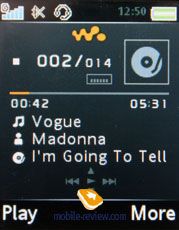 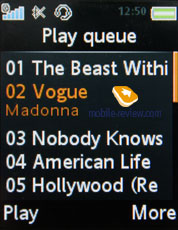
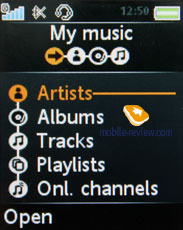 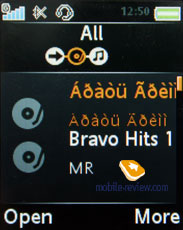
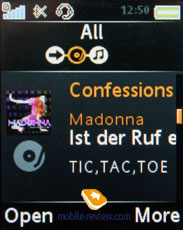 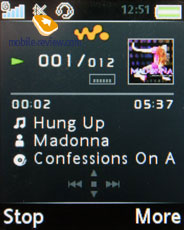
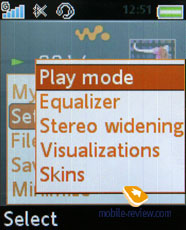 
Player was reworked not only in range of interface, there are also changes in playback algorithm, or it’s just a subjective effect affection. Playback quality has slightly improved upon the first version of Walkman player.
For a start you need to upload your own music collection to the device, in order to perform this, use Disc2Phone application – it copies all files to the folder, containing music. Besides, this program may be applied to moving contents of your CDs, since all files stored on compact-disks are automatically converted into MP3. In case you want to set up the music collection on your own, you will just require copying files to any folder, or creating a new one. Nesting level doesn’t affect a thing here, as the device checks the memory without your help. Having finished copying data, you will need to update the music library – this is performed via a special function – the handset locates all files and folders, and then gets the necessary data from ID3-tags. Supported audio formats - MP3, AAC, AAC+, E-AAC+, WAV, WMA and m4a. There are no limitations on bit rates; you can also upload files with VBR. The company recommends using files with 192 Kbit/s bit rate.
In the music library, all saved tracks are classified by the following characteristics:
- Artists – the application displays general list of artists in alphabetical order, one can conduct a fast search here;
- Albums – sorting by albums’ titles, search function is available as well;
- Tracks –general list of all tracks, sorting is conducted by tracks’ titles or ID3 tags;
- Genre – sorting, which uses various music styles, like Hip Hop, Jazz, Blues as criteria;
- My playlists – these are playlists, made up by user, that can be created both on the device and on PC, while viewing contents of the flash memory in USB Mass Storage mode; the handset also locates then when updates the library.
Horizontal shifts between different tabs allow viewing not only album, but also artists list and songs. All navigation can be done via one or few touches, and on each list you can use search by first or several letters.
In playback mode you can select whether corresponding image will be displayed (matching album) or Visualization (sort of screensaver that acts in tact with sound). Repeat of a single and all songs can be enabled, as well as Shuffle mode. Rewinding is progressive, if you hold the button, steps change.
There’s demo playback mode, that way player will play first few seconds of each song.
HPM-70 headphones are shipped with the handset, they are using Fast Port interface connector, meanwhile on the cord you will find 3.5mm jack for typical headphones. The quality of the headphones is one of the best on the market, although they slightly yield to the ones coming boxed with Nokia N91. On the other hand, rubber fittings are more comfortable, as they will suit most consumers, and feel better in day-to-day use.
Phone supports OMA DRM 2.0, which makes it compatible with almost all online shops that sell music. Manufacturer included Online channels menu item, here you can add different online shops. Depending on your operator and weather phone is sold by one or not, links in that menu may vary. New links can be downloaded with help of your operator, but that’s possible only in few countries including Russia, but this will not be actual in upcoming years. An important fact is that download service works in minimized mode, you can order music without exiting player.
TrackID. Just like in Sony Ericsson W850i this handset has TrackID service, that’s when you can find out song’s title when listening to it on radio or recording it via microphone. Usually it takes around 3-4 seconds for length, later on file gets transferred to server GraceNote, where it interacts with huge data base. Unlike other models in W880i you can not only get song title, but also buy it. Service is interesting due to momentum, instant and impulsive ability of buying that song you were looking for. It’s hard to say something else about this service. The attempt to boost popularity of this service is natural – the manufacturer has even granted it an own menu item.
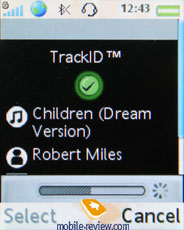
Performance. The model puts up nothing special in terms of performance for the handsets of the company’s latest generation, yet it does better than most of other offerings available on the market. Low screen resolution compared to senior models, has a positive impact on the W660i’s performance – the interface works at the light-speed. There are no caps on JAR files, while HEAP can make up from 512 Kb to 1.5 Mb in size.
Impressions
Despite the polyphony having 40 chords in the W660i, the handset does not provide a breakthrough in sounding of mp3 tunes compared to other Sony Ericsson branded phones. Volume-wise, performing on average level on this front, the W660i is pretty much akin to Sony Ericsson K790/K800/W810. Be sure you will hear the handset outdoors. The silent alert provides average strength. The reception part is on the same level with that of other products by the Sony Ericsson – in other words, it’s very fine.
This model has turned out to be a handset worth looking at, being almost an exact replica of Sony Ericsson W610i, but with 3G support thrown in for good measure. The quality of shots taken with the built-in camera is much worse, as well as its specifications.
Do you really need a camera or 3G connectivity? It is up to you, though the keypad and standard location of the interface jack are definitely on the handset’s list of advantages. It will be retailed for approximately 40 Euros more than Sony Ericsson W610i, leading us to 370-390 Euros in late May, when it is hitting the market. The manufacturer is trying to position this solution as an emotional handset, therefore not hoping for breaking sales and rather offers the solution for a narrow audience. This is somewhat justified in our opinion, this handset will have some success. The major trump of the W660i is its design, flashy looks and the functionality we have come to expect from Sony Ericsson-branded solutions.
Eldar Murtazin (eldar@mobile-review.com)
Translated by Oleg Kononosov (oleg.kononosov@mobile-review.com)
Published — 25 april 2007
Have something to add?! Write us... eldar@mobile-review.com
|
News:
[ 31-07 16:21 ]Sir Jony Ive: Apple Isn't In It For The Money
[ 31-07 13:34 ]Video: Nokia Designer Interviews
[ 31-07 13:10 ]RIM To Layoff 3,000 More Employees
[ 30-07 20:59 ]Video: iPhone 5 Housing Shown Off
[ 30-07 19:12 ]Android Fortunes Decline In U.S.
[ 25-07 16:18 ]Why Apple Is Suing Samsung?
[ 25-07 15:53 ]A Few Choice Quotes About Apple ... By Samsung
[ 23-07 20:25 ]Russian iOS Hacker Calls It A Day
[ 23-07 17:40 ]Video: It's Still Not Out, But Galaxy Note 10.1 Gets An Ad
[ 19-07 19:10 ]Another Loss For Nokia: $1 Billion Down In Q2
[ 19-07 17:22 ]British Judge Orders Apple To Run Ads Saying Samsung Did Not Copy Them
[ 19-07 16:57 ]iPhone 5 To Feature Nano-SIM Cards
[ 18-07 14:20 ]What The iPad Could Have Looked Like ...
[ 18-07 13:25 ]App Store Hack Is Still Going Strong Despite Apple's Best Efforts
[ 13-07 12:34 ]Infographic: The (Hypothetical) Sale Of RIM
[ 13-07 11:10 ]Video: iPhone Hacker Makes In-App Purchases Free
[ 12-07 19:50 ]iPhone 5 Images Leak Again
[ 12-07 17:51 ]Android Takes 50%+ Of U.S. And Europe
[ 11-07 16:02 ]Apple Involved In 60% Of Patent Suits
[ 11-07 13:14 ]Video: Kindle Fire Gets A Jelly Bean
Subscribe
|
